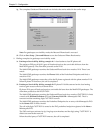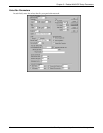
Chapter 3 – Related MultiVOIP Setup Parameters
Multi-Tech Systems, Inc. Avaya Communication Manager Guide 35
Communication Manager Parameter Definitions (cont’d)
Field Name Values Description
RAS Time to
Live
Numeric
(in seconds)
The MultiVOIP sends this value to CM in the Registration Request
(RRQ). However, the MultiVOIP will send “Keepalive” RRQs based
on the TTL received from CM durin
g
Re
g
istration Confirm (RCF)
Enable
Survivability
Mode
Y/N Enable/disable MultiVOIP’s Gateway Survivable mode wherein
MultiVOIP manages its own IP traffic using its inbound and
outbound phonebooks in the event of failure of the primary, alternate
#1 and #2
g
atekee
p
ers (if alternates are
p
resent).
Switching
Time Interval
numeric
(in seconds)
When MultiVOIP is in “gateway” survivable mode meaning the
Communication Manager gatekeeper to which it is registered failed
(along with any alternate gatekeepers providing redundancy), the
MultiVOIP manages IP phone traffic with its own phonebooks. It
will seek to return to being controlled by the Communication
Manager gatekeeper. The Switching Time Interval determines how
often it will seek to restore its registration with the primary
Communication Mana
g
er
g
atekee
p
er.
H.323 Version 4 Parameters
Q.931
Multiplexing
(Mux)
Y/N Signaling for multiple phone calls can be carried on a single port
rather than opening a separate signaling port for each call. This
conserves bandwidth resources.
If
“Register with Communication Manager Gatekeeper” is enabled, this
field defaults to “Y” for FXO/DID ports and to “N” for FXS ports
and it cannot be changed.
H.245
Tunneling
(Tun)
Y/N H.245 messages are encapsulated within the Q.931 call-signaling
channel. Among other things, the H.245 messages let the two
endpoints tell each other what their technical capabilities are and
determine who, during the call, will be the client and who the server.
Tunneling is the process of transmitting these H.245 messages
through the Q.931 channel. The same TCP/IP socket (or logical port)
already being used for the Call Signaling Channel is then also used
by the H.245 Control Channel. This encapsulation reduces the
number of logical ports (sockets) needed and reduces call setup time.
If
“Register with Communication Manager Gatekeeper” is enabled, this
field defaults to “Y” for FXS and FXO ports and cannot be changed.
H.323 Version 4 Parameters
Parallel H.245
(FS + Tun)
Y/N
FS (Fast Start or Fast Connect) is a Q.931 feature of H.323v2 to
hasten call setup as well as ‘pre-opening’ the media channel before
the CONNECT message is sent. This pre-opening is a requirement
for certain billing activities. Under Parallel H.245 FS + Tun, this Fast
Connect feature can operate simultaneously with H.245 Tunneling
(see description above).
If
“Register with Communication Manager Gatekeeper” is enabled, this
field defaults to “N” for FXS and FXO ports and cannot be changed.
Annex –E (AE) Y/N
Multiplexed UDP call signaling transport. Annex E is helpful for
high-volumeVOIP system endpoints. Gateways with lesser volume
can afford to use TCP to establish calls. However, for larger volume
endpoints, the call setup times and system resource usage under
TCP can become problematic. Annex E allows endpoints to perform
call- signaling functions under the UDP protocol, which involves
substantially streamlined overhead. (This feature should not be
used on the public Internet because of potential problems with
security and bandwidth usage.)
If
“Register with Communication Manager Gatekeeper” is enabled, this
field defaults to “N” for FXS and FXO ports and cannot be changed.


















